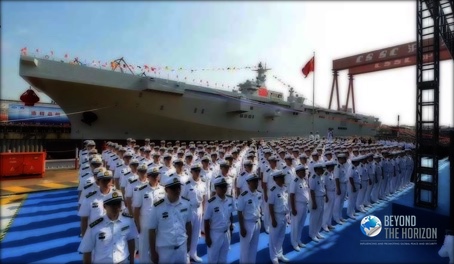On September 25, China launched its first type-075-class Land Helicopter Dock. Following this event, a notable amount of coverage has been generated over the last weeks. Many experts and columnists may have over-emphasized the role of China’s new vessel regarding a potential Chinese invasion on Taiwan. Although the type-075 could certainly improve Beijing’s capability to launch an assault on the neighboring island, this new Land Helicopter Dock should be conceived as a steppingstone rather than a game-changer for such contingency/scenario. According to different sources, the second vessel of this type is already under construction, while the construction of a third one is arguably envisaged. Although officially launched, China’s new Land Helicopter Dock is still under completion; electronics, radars, as well as other equipment still need to be incorporated to the vessel before it will be able to go on sea trials. It might take one year or more before the first type-075 will become fully operational and enter active service within the Chinese navy.
China has taken an important step forward in regard to its amphibious and naval capabilities. Unlike, its smaller brother, the type-071, a landing platform dock (LPD), the new type-075 design will allow the Chinese navy to enhance its power projection further ashore, and to a greater extent. The type-075 has a bigger payer load which will allow it to carry up to 30 helicopters, and between 800 – 1800 marines onboard. Moreover, a higher number of amphibious assault vehicles, landing craft vehicles, and air-cushioned landing crafts will be carried on the type-075, thus increasing China’s capabilities to conduct offensive operations from the sea. The type-075 could even become a light aircraft carrier by operating vertical takeoff and landing aircraft (VTOL) and short takeoff and vertical landing aircraft (STOVL) from its deck. However, China does not presently have any equivalent to the F-35B, but it would not be surprising to see China acquire these capabilities in the near future. China has proved it can develop, innovate, and in other cases copy complex military equipment and technologies at a steady pace.
China’s high pace naval build-up over the recent years is impressive – China has, in fact, launched a higher tonnage of ships for the period 2014-2018 than the aggregate tonnages of the French and Indian navy – albeit not yet sufficient to currently provide Beijing with the necessary capabilities it needs to conduct an invasion of Taiwan. Indeed, although Beijing could use the type-075 in the future for a Taiwan invasion-like scenario, modern amphibious capabilities have only recently been incorporated within the Chinese navy. Over the last decades, China has focused on mainly developing destroyers, frigates, corvettes, cruisers, and carriers aircraft to the detriment of other projects. The type-071 programme, for instance, started in 2002 while the type-075 development programme started in 2011. For the rest, China’s remaining amphibious capabilities are older and less capable as compared to the type-071 and the type-075. The latter being the flagship of China’s amphibious capabilities.
As shown with the US-led military coalition against ISIS, exerting control or invading a territory requires putting boots off the ground, regardless of the air and technological power one might have. Yet, the US coalition relied on different local groups to fill the gap. This might not be the case for China, which would need to gather a huge number of vessels and amphibious means to transport and provide the required logistics to the thousands of soldiers crossing the Taiwan Strait. Launching a full-scale invasion by amphibious means is one of the most complex operations of warfare. According to different sources, China would need between 20 to 40 divisions to invade Taiwan. Nevertheless, present Chinese capacity to mobilize this number of troops falls short, the Chinese navy sealift capability is of four divisions while an additional number of 8 to 12 division could be provided by requisitioning commercial vessels.
A full-scale invasion would however certainly not be the most politically sound option to reunify Taiwan with the mainland. China has many other options it could use to exert pressure on Taiwanese decision-makers. Continuously isolating Taiwan by imposing an exclusive choice between Taipei and Beijing to countries that are willing to strengthen diplomatic relations with China or imposing a naval blockade might prove more effective in the short-term to further the One-China policy. In the mid-term, the worst-case scenario argues, China would use its new amphibious capabilities, to launch an attack on Quemoy and Matsu Islands to send out a political signal against Taiwan’s independence aspirations or to simply compel its neighbor to reunify with the mainland.
Elsewhere in the region, China will certainly use its ever-growing amphibious capabilities in the South China Sea, and the East China Sea to a lesser extent, to exert more pressure against neighbors with whom it has opposite territorial claims. Landing Helicopters Docks in combination with carriers aircraft – one aircraft is currently fully operational, the second is on sea trials while a third one is currently under construction – will improve China’s conventional deterrence, its air superiority as well as its ability to seize other nations outposts in the South China Sea.
Conversely, new amphibious capabilities such as the type-075 will also improve China’s soft power. Indeed, Landing Helicopter Decks are versatile tools of foreign policy that can be used for various types of missions such as humanitarian assistance, arms control, peacekeeping and other military operations other than hard power Unlike, what has often been portrayed, China’s type-075 unveiling is a steppingstone, an important one, yet not a game-changer. This new vessel will allow China to reinforce its hard, and soft power, as well as its ability to conduct a complete set of operations from the sea, thus allowing China to enhance its engagements in global affairs.
* Victor Mahieu is Defence Analyst at Beyond the Horizon ISSG
Contact
Phone
Tel: +32 (0) 2 801 13 57-58
Address
Beyond the Horizon ISSG
Davincilaan 1, 1932 Brussels

